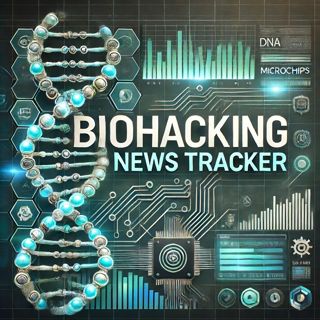![The Booming Biohacking Industry: Reshaping Personal Health and Performance [140 characters]](https://cdn.podme.com/podcast-images/B6FFFEA0001FB41783B1712CC5D51C6A_small.jpg)
The Booming Biohacking Industry: Reshaping Personal Health and Performance [140 characters]
The biohacking industry is experiencing rapid growth, driven by increasing consumer interest in self-optimization and personalized health solutions. Recent market research indicates that the global biohacking market is expected to reach significant values by 2032, with compound annual growth rates (CAGR) ranging from 18.4% to 18.9%[1][2][5].Key market segments include wearable health devices, genetic testing, neuro-enhancement products, and DIY biology. Wearable devices, particularly smartwatches and fitness trackers, dominate the market due to their widespread adoption for health monitoring and fitness tracking[3][4].North America currently holds the largest market share, driven by the presence of strategic actors in developed countries such as the U.S. and Canada. However, the Asia Pacific region is expected to witness rapid growth due to increasing health consciousness and technological advancements[2][4].Recent developments include the integration of artificial intelligence (AI) and the Internet of Things (IoT) in healthcare, which is reshaping the biohacking landscape. Companies are investing in biohacking innovations to improve healthcare accessibility and performance optimization[1][5].Consumer behavior is shifting towards a greater emphasis on longevity, cognitive enhancement, and metabolic health, leading to increased demand for biohacking products and services. However, ethical concerns and regulatory challenges continue to shape the industry's future[5].Industry leaders are responding to current challenges by introducing biohacking-enabled products and investing in research and development. For example, Apple Inc. has contributed to market growth by introducing biohacking-enabled products, reinforcing the role of major tech companies in the sector[5].In terms of market size, the global biohacking market was valued at USD 25.3 billion in 2024 and is expected to reach USD 168.3 billion by 2035, growing at a CAGR of 18.8%[3]. Another report estimates the market to be worth around USD 83 billion by 2032, growing at a CAGR of 18.4%[5].Overall, the biohacking industry is poised for significant growth, driven by technological advancements, increasing consumer interest, and the convergence of biotechnology and information technology. As the industry continues to evolve, it is essential to address ethical concerns and regulatory challenges to ensure safe and effective advancements in biohacking.This content was created in partnership and with the help of Artificial Intelligence AI
7 Feb 2min

Biohacking Boom: The Rise of Self-Optimization and the Future of the $113 Billion Market
The biohacking industry is experiencing rapid growth, driven by increasing consumer interest in self-optimization and advancements in technology. According to recent market research, the global biohacking market is expected to reach USD 113.03 billion by 2032, growing at a compound annual growth rate (CAGR) of 18.50% between 2025 and 2032[1][2].Key drivers of this growth include the rising demand for personalized health solutions, advancements in wearable technology, and the growing elderly population seeking longevity and health optimization. The market is also fueled by the increasing adoption of biohacking products and services, such as genetic testing, nootropics, and neuro-enhancement technologies[2][5].North America is anticipated to lead the market due to its robust regulatory framework, diverse population with varying health needs, and increased consumer awareness and education. The Asia Pacific region is expected to grow at the fastest pace, driven by rising consumer awareness and technological innovations[4][5].Recent market movements include significant investments by pharmaceutical and biotech enterprises in biohacking technology, particularly in the development of faster medications and therapies. The increasing popularity of biohacking activities such as wearable devices and nootropics is also propelling market expansion[4].Emerging competitors in the biohacking market include startups and well-established players offering new solutions and techniques aimed at better health and lifestyle. Companies like Apple Inc. are contributing to market growth by introducing biohacking-enabled products, reinforcing the role of major tech companies in the sector[5].However, the biohacking industry faces challenges such as regulatory issues, data privacy concerns, and ethical debates. The high price of biohacking solutions and lack of education and awareness among potential users are also restraining factors for market growth[2][5].In response to these challenges, industry leaders are focusing on consumer education, partnerships, and innovations to distinguish themselves. For example, nutraceutical companies are developing dietary products and supplements for better health, while wearables manufacturing companies are delivering solutions and devices that effectively track diverse health metrics[2].Compared to previous reporting, the current market conditions show a significant increase in market size and growth rate. The market size was estimated to be USD 18.75 billion in 2023 and is expected to reach USD 83 billion by 2032, growing at a CAGR of 18.4%[4][5].In conclusion, the biohacking industry is experiencing rapid growth driven by increasing consumer interest in self-optimization and advancements in technology. Despite challenges, industry leaders are responding with innovative solutions and strategies to address regulatory issues, data privacy concerns, and ethical debates. The market is expected to continue growing, with North America leading the way and the Asia Pacific region showing the fastest growth.This content was created in partnership and with the help of Artificial Intelligence AI
6 Feb 3min

The Biohacking Boom: Transforming Personal Healthcare
The biohacking industry is experiencing significant growth, driven by increasing consumer interest in personalized healthcare solutions and rapid advancements in biotechnology. According to recent market research, the global biohacking market is expected to reach USD 83 billion by 2032, growing at a compound annual growth rate (CAGR) of 18.4% from 2024 to 2032[3][5].Key drivers of this growth include the rising demand for wearable health devices, genetic testing, and nootropic supplementation. Wearable medical devices, in particular, accounted for the largest revenue share at over 34%, while the monitoring segment dominated the market with over 32% of revenue[3][5].North America led the market with a 39% revenue share, followed by Asia Pacific, driven by rising consumer awareness and technological innovations[3][5]. The US biohacking market is poised to grow at a sustainable CAGR, fueled by a robust regulatory framework, diverse population demands, and increased consumer awareness[4].Emerging trends in the biohacking industry include microbiome engineering, synthetic biology, and the integration of Eastern and Western medicine. Companies such as Apple Inc. are contributing to market growth by introducing biohacking-enabled products, reinforcing the role of major tech companies in the sector[3].However, the biohacking market faces challenges such as regulatory issues, data privacy concerns, and ethical debates. The high cost of biohacking solutions, lack of education, and low awareness are also hindering market adoption and innovation[1][4].In response to these challenges, industry leaders are focusing on consumer education, partnerships, and innovations to distinguish themselves. For example, nutraceutical companies like Nutritional Biochemistry and Garden of Life are offering dietary products and supplements for better health, while wearables manufacturing companies like Garmin, Fitbit, and Apple are delivering solutions and devices that effectively track diverse health metrics[4].Compared to previous reporting, the current market conditions indicate a significant shift in consumer behavior towards personalized healthcare solutions. The increasing adoption of biohacking products and services is driven by a growing awareness of the potential benefits of biohacking, alongside a rising global health consciousness among consumers[1][3].In conclusion, the biohacking industry is experiencing remarkable growth, driven by advancements in biotechnology and growing consumer interest in personalized healthcare. Despite challenges, industry leaders are responding with innovative solutions, partnerships, and consumer education, positioning the market for continued growth and transformation in the healthcare sector.This content was created in partnership and with the help of Artificial Intelligence AI
5 Feb 3min

The Biohacking Boom: Transforming Personal Health and Wellness
The biohacking industry is experiencing rapid growth, driven by increasing consumer interest in personalized healthcare solutions and advancements in biotechnology. Recent market research indicates that the global biohacking market is expected to reach USD 83 billion by 2032, growing at a compound annual growth rate (CAGR) of 18.4% from 2024 to 2032[2][3].Key drivers of this growth include the rising demand for wearable devices, nootropic supplements, and genetic testing. Wearable medical devices, in particular, accounted for the largest revenue share, exceeding 34%[2][3]. The monitoring segment dominated the market, holding more than 32% of revenue, with treatment applications projected to grow at the fastest CAGR[2][3].North America led the market with a 39% revenue share, followed by Asia Pacific, driven by rising consumer awareness and technological innovations[2][3]. Companies such as Apple Inc. have contributed to market growth by introducing biohacking-enabled products, reinforcing the role of major tech companies in the sector[2].However, the biohacking market faces challenges, including regulatory issues, data privacy concerns, and ethical debates. Strict regulatory frameworks, particularly those associated with health claims and genetic modifications, may hinder market adoption and innovation[1][4]. Additionally, the high cost of biohacking solutions and lack of education and awareness among potential users may limit market growth[1][4].Despite these challenges, the biohacking industry presents significant opportunities for growth and innovation. The market's potential to revolutionize personal health, longevity, and cognitive enhancement is vast, with cutting-edge technologies and personalized wellness solutions likely to shape the future of healthcare[1][4].In response to current challenges, industry leaders are focusing on developing more accessible and affordable biohacking solutions. For example, companies are investing in research and development to improve the accuracy and effectiveness of genetic testing and wearable devices[1][4]. Additionally, there is a growing trend towards DIY biology and biohacking spaces, fostering global collaboration and innovation[3].Compared to previous reporting, the current market conditions indicate a significant increase in consumer interest and investment in biohacking solutions. The market's growth rate has accelerated, driven by advancements in biotechnology and the rising demand for personalized healthcare solutions[1][2][3]. However, regulatory challenges and ethical concerns remain a key focus for industry leaders and stakeholders.In conclusion, the biohacking industry is poised for explosive growth, driven by increasing consumer interest and advancements in biotechnology. While challenges remain, the market's potential to revolutionize personal health and wellness is vast, with industry leaders responding to current challenges by developing more accessible and affordable biohacking solutions.This content was created in partnership and with the help of Artificial Intelligence AI
4 Feb 3min

Biohacking Boom: Transforming Healthcare and Self-Optimization
The biohacking industry is experiencing rapid growth, driven by increasing consumer interest in personalized healthcare solutions and advancements in biotechnology. Recent market research indicates that the global biohacking market is expected to reach USD 83 billion by 2032, growing at a compound annual growth rate (CAGR) of 18.4% from 2024 to 2032[2][5].Key segments driving this growth include wearable devices, nootropic drugs, and innovative technologies like neurofeedback and CRISPR. Wearable medical devices, in particular, accounted for the largest revenue share at over 34%, highlighting the growing reliance on health-monitoring technology[2][5].North America dominates the biohacking market, with a 39% revenue share, followed by Asia Pacific. The region's strategic presence in developed countries such as the U.S. and Canada, along with the advent of biotechnology and synthetic biology, are expected to fuel business growth[2][4].Emerging trends such as microbiome engineering, synthetic biology, and the integration of Eastern and Western medicine are expanding possibilities in the biohacking industry. The rise of DIY biology and biohacking spaces fosters global collaboration and innovation, while regulatory bodies emphasize safety and oversight[2][5].Consumer behavior is shifting towards a greater emphasis on self-optimization, with individuals increasingly taking control of their health and performance through biohacking techniques. This includes the use of nootropic drugs, external and internal implants, and DIY biohacking setups in unconventional spaces[2][5].Industry leaders are responding to current challenges by investing in biohacking innovations, aiming to improve healthcare accessibility and performance optimization. For example, Apple Inc. has contributed to market growth by introducing biohacking-enabled products, reinforcing the role of major tech companies in the sector[2].Comparing current conditions to previous reporting, the biohacking market has seen significant growth over the past year. The market size was valued at USD 20.17 billion in 2023 and is expected to reach USD 95.80 billion by 2032, growing at a CAGR of 18.9%[4].In conclusion, the biohacking industry is experiencing remarkable growth, driven by advancements in biotechnology and growing consumer interest in personalized healthcare. With emerging trends and innovations on the horizon, the market is poised to redefine healthcare, offering transformative solutions to enhance health, performance, and longevity.This content was created in partnership and with the help of Artificial Intelligence AI
3 Feb 2min

Biohacking Boom: Transformative Solutions for Enhanced Health and Longevity
The biohacking industry has experienced significant growth in recent years, driven by increasing consumer interest in personalized healthcare solutions and advancements in biotechnology. Over the past 48 hours, several key developments have emerged that highlight the current state of the industry.Market research indicates that the global biohacking market is projected to grow from $19 billion in 2023 to $83 billion by 2032, with a compound annual growth rate (CAGR) of 18.4%[1]. This growth is attributed to the rising demand for smart devices and effective drugs, growing awareness about biohacking, and the increasing prevalence of chronic diseases.In terms of recent market movements, the biohacking market size is expected to increase from $36.61 billion in 2024 to $45.16 billion in 2025, with a CAGR of 23.4%[2]. This rapid expansion is driven by the surge in health consciousness, increased information accessibility, entrepreneurial culture, and the quantified self-movement.Emerging trends in the biohacking industry include the integration of IoT and smart medical devices, microbiome engineering, synthetic biology, and the combination of Eastern and Western medicine. These advancements are expanding possibilities for health monitoring, disease management, and diagnostics[1][3].Industry leaders are responding to current challenges by investing in research and development, forming strategic partnerships, and launching new products. For example, technology company Blackbook.ai has developed a virtual assistant to help health professionals tackle contact tracing, and companies like Fitbit and Apple are leading the market with innovative wearable devices[2][4].In comparison to previous reporting, the current market conditions show a significant increase in market size and growth rate. The market size was estimated at USD 19 billion in 2023, up from USD 20.17 billion in the base year 2023, and is expected to reach USD 83 billion to USD 113.03 billion by 2032[2][5].Key players in the biohacking market include Thync Global, Inc., Health Via Modern Nutrition Inc., Apple Inc., The ODIN, Fitbit, Inc., Nuanic, and Muse. These companies are transforming well-being by combining technology, science, and human performance[3].The biohacking market in North America dominated the market in 2023 with a market share of 36.7%, followed by Asia Pacific, which is expected to witness significant growth due to the revamping healthcare sector and growing investment in biohacking technologies[3][4].In conclusion, the biohacking industry is experiencing remarkable growth, driven by advancements in biotechnology and growing consumer interest in personalized healthcare. As the industry continues to evolve, it is expected to offer transformative solutions to enhance health, performance, and longevity. Industry leaders are responding to current challenges by investing in research and development, forming strategic partnerships, and launching new products. The current market conditions show a significant increase in market size and growth rate, with the market expected to reach USD 83 billion to USD 113.03 billion by 2032.This content was created in partnership and with the help of Artificial Intelligence AI
31 Jan 3min

Biohacking Boom: Transforming Healthcare with Tech, Science, and Human Performance
The biohacking industry is experiencing rapid growth, driven by increasing consumer interest in personalized healthcare solutions and advancements in biotechnology. Recent market research indicates that the global biohacking market is expected to grow at a compound annual growth rate (CAGR) of 18.50% between 2025 and 2032, reaching an estimated value of over USD 113.03 billion by the end of the forecast period[1].Key factors driving this growth include the rising demand for smart devices and effective drugs, growing prevalence of chronic diseases, and increasing awareness about biohacking practices. Wearable health devices, genetic testing kits, and smart drugs are among the most popular biohacking products, with wearable devices accounting for the largest revenue share due to their widespread adoption for health monitoring and fitness tracking[3][4].North America is expected to dominate the biohacking market during the forecast period, with the U.S. leading the market due to heavy investments in research and development by the government and key market players[2][4]. Europe and Asia Pacific are also anticipated to witness significant growth, driven by rising healthcare expenditure and increasing awareness about biohacking practices.Recent trends in the biohacking market include the integration of IoT and smart medical devices, which are enhancing health monitoring, disease management, and diagnostics. The use of nootropic drugs, external and internal implants, and DIY biohacking setups in unconventional spaces are also gaining popularity[5].Industry leaders are responding to current challenges by investing in research and development, launching new products, and forming partnerships. For example, companies like Fitbit, Inc., Apple Inc, and Thync Global Inc. are transforming well-being by combining technology, science, and human performance[2][4].Compared to previous reporting, the biohacking market has seen significant growth, with the market size increasing from USD 20.94 billion in 2023 to an estimated USD 113.03 billion by 2032[1][4]. The market is expected to continue growing, driven by increasing consumer interest in personalized healthcare solutions and advancements in biotechnology.In conclusion, the biohacking industry is experiencing rapid growth, driven by increasing consumer interest in personalized healthcare solutions and advancements in biotechnology. Industry leaders are responding to current challenges by investing in research and development, launching new products, and forming partnerships. The market is expected to continue growing, with North America, Europe, and Asia Pacific being key regions driving this growth.This content was created in partnership and with the help of Artificial Intelligence AI
30 Jan 3min

The Booming Biohacking Market: Transforming Healthcare, Performance, and Longevity
The biohacking industry is experiencing significant growth, driven by increasing consumer interest in personalized healthcare solutions and advancements in biotechnology. Recent market research indicates that the global biohacking market is expected to grow at a compound annual growth rate (CAGR) of 18.4% to 18.9% between 2025 and 2032, reaching an estimated value of USD 83 billion to USD 113.03 billion by the end of the forecast period[1][2][5].Key factors contributing to this growth include the rising demand for smart devices and effective drugs, growing awareness about biohacking, and the increasing prevalence of chronic diseases. Wearable devices, particularly wearable medical devices, accounted for the largest revenue share at over 34%, with applications in health monitoring, fitness tracking, and personalized insights[5].North America currently dominates the biohacking market, backed by the strategic presence of key players in the U.S. and Canada. However, the Asia Pacific region is expected to witness rapid development due to the revamping healthcare sector and growing investment in biohacking technologies[2][4].Emerging trends in the biohacking industry include the integration of IoT and smart medical devices, microbiome engineering, synthetic biology, and the combination of Eastern and Western medicine. These advancements are expanding possibilities for health monitoring, disease management, and diagnostics[5].Regulatory bodies are emphasizing safety and oversight, particularly in genetic engineering experiments and the use of patient safety information. Despite these challenges, the biohacking market is poised to redefine healthcare, offering transformative solutions to enhance health, performance, and longevity[2][4].Industry leaders are responding to current challenges by investing in research and development, forming strategic partnerships, and launching new products. For example, technology company Blackbook.ai has developed a virtual assistant to help health professionals tackle contact tracing, and companies like Fitbit and Apple are leading the market with innovative wearable devices[2][4].In comparison to previous reporting, the current market conditions show a significant increase in market size and growth rate. The market size was estimated at USD 19 billion in 2023, up from USD 20.17 billion in the base year 2023, and is expected to reach USD 83 billion to USD 113.03 billion by 2032[2][5].Overall, the biohacking industry is experiencing remarkable growth, driven by advancements in biotechnology and growing consumer interest in personalized healthcare. As the industry continues to evolve, it is expected to offer transformative solutions to enhance health, performance, and longevity.This content was created in partnership and with the help of Artificial Intelligence AI
30 Jan 3min





















